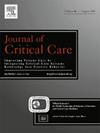Sex-based differences in ICU management and outcomes of immunocompromised patients: A post hoc analysis of the prospective multicenter multinational Efraim cohort
IF 3.2
3区 医学
Q2 CRITICAL CARE MEDICINE
引用次数: 0
Abstract
Purpose
There may be sex-based disparities in intensive care unit (ICU) management and outcomes. We compared baseline variables, interventions, and outcomes of immunocompromised critically ill men and women.
Methods
We performed a post hoc analysis of the Efraim study, a prospective multinational cohort study of immunocompromised adults with acute hypoxemic respiratory failure admitted to one of 68 ICU in 16 countries between November 2015 and July 2016. We compared in unadjusted and adjusted analyses baseline variables, ICU interventions, and outcomes between men and women.
Results
We included 1536 immunocompromised adults (922 men, 614 women) in this study. Women and men had similar age, BMI, and diagnoses leading to immunosuppression; hematopoietic cell transplant was more common in men. On the first ICU day, SOFA score was higher in men vs. women (7 [IQR 4–10] vs 6 [4–10]), p = 0.0005). The use of ICU supportive interventions, including mechanical ventilation, vasopressors, renal replacement, bronchoalveolar lavage, and ARDS adjuncts, were similar between men and women; as were mortality in ICU, in hospital, and at 90 days. After adjustment, female sex (sub-hazard ratio 1.19, 95 % CI 1.05–1.36, p = 0.007), SOFA score on ICU day 1 (sHR 1.16, 95 % CI 1.12–1.19, p < 0.001) and chronic kidney disease (sHR 0.74, 95 % CI 0.59–0.93, p = 0.009) were associated with mechanical ventilation. Age, performance status and SOFA score on ICU day 1 were associated with hospital mortality.
Conclusions
In this post hoc analysis of immunocompromised adult ICU patients with hypoxemic respiratory failure, women and men received similar ICU interventions, and had similar outcomes.
基于性别的ICU管理差异和免疫功能低下患者的结局:前瞻性多中心多国Efraim队列的事后分析
目的重症监护病房(ICU)的管理和预后可能存在性别差异。我们比较了免疫功能低下的危重症男性和女性的基线变量、干预措施和结果。方法:我们对Efraim研究进行了事后分析,Efraim研究是一项前瞻性多国队列研究,研究对象是2015年11月至2016年7月在16个国家的68个ICU收治的急性低氧性呼吸衰竭免疫功能低下的成年人。我们比较了未调整和调整分析的基线变量、ICU干预措施和男女之间的结果。结果我们纳入了1536名免疫功能低下的成年人(922名男性,614名女性)。女性和男性具有相似的年龄、BMI和导致免疫抑制的诊断;造血细胞移植在男性中更为常见。在ICU第一天,男性患者的SOFA评分高于女性患者(7 [IQR 4-10] vs 6 [4-10]), p = 0.0005。ICU支持干预措施的使用,包括机械通气、血管加压药物、肾脏替代、支气管肺泡灌洗和ARDS辅助工具,在男性和女性之间相似;重症监护病房、住院和90天的死亡率也是如此。调整后,女性(亚危险比1.19,95% CI 1.05 ~ 1.36, p = 0.007)、ICU第1天SOFA评分(sHR 1.16, 95% CI 1.12 ~ 1.19, p <;0.001)和慢性肾脏疾病(sHR 0.74, 95% CI 0.59-0.93, p = 0.009)与机械通气相关。年龄、功能状态和ICU第1天SOFA评分与住院死亡率相关。结论:在对低氧血症性呼吸衰竭的免疫功能低下成人ICU患者的事后分析中,女性和男性接受了相似的ICU干预,并且结果相似。
本文章由计算机程序翻译,如有差异,请以英文原文为准。
求助全文
约1分钟内获得全文
求助全文
来源期刊

Journal of critical care
医学-危重病医学
CiteScore
8.60
自引率
2.70%
发文量
237
审稿时长
23 days
期刊介绍:
The Journal of Critical Care, the official publication of the World Federation of Societies of Intensive and Critical Care Medicine (WFSICCM), is a leading international, peer-reviewed journal providing original research, review articles, tutorials, and invited articles for physicians and allied health professionals involved in treating the critically ill. The Journal aims to improve patient care by furthering understanding of health systems research and its integration into clinical practice.
The Journal will include articles which discuss:
All aspects of health services research in critical care
System based practice in anesthesiology, perioperative and critical care medicine
The interface between anesthesiology, critical care medicine and pain
Integrating intraoperative management in preparation for postoperative critical care management and recovery
Optimizing patient management, i.e., exploring the interface between evidence-based principles or clinical insight into management and care of complex patients
The team approach in the OR and ICU
System-based research
Medical ethics
Technology in medicine
Seminars discussing current, state of the art, and sometimes controversial topics in anesthesiology, critical care medicine, and professional education
Residency Education.
 求助内容:
求助内容: 应助结果提醒方式:
应助结果提醒方式:


